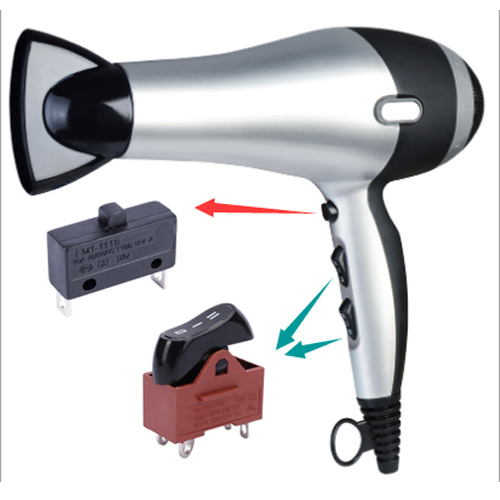How to choose a right switch for your appliance?
How to choose a right switch for your appliance?
There are three important features to consider when choosing a switch:
· Contacts (e.g. single pole, double throw)
· Ratings (maximum voltage and current)
· Method of Operation (toggle, slide, key etc.)
Switch Contacts
Several terms are used to describe switch contacts:
Several terms are used to describe switch contacts:
· Pole - Number of switch contact sets.
· Throw - Number of conducting positions, single or double.
· Way - Number of conducting positions, three or more.
· Momentary - Switch returns to its normal position when released.
· Open - Off position, contacts not conducting.
· Closed - On position, contacts conducting, there may be several on positions.
· Size : The length,height and width for the rocker switch
ON-OFF
Single Pole, Single Throw = SPST
A simple on-off switch.
This type can be used to switch the power supply to a circuit.
When used with mains electricity this type of switch must be in the live wire, but it is better to use a DPST switch to isolate both live and neutral.
(ON)-OFF
Push-to-make = SPST Momentary on
A push-to-make switch returns to its normally open (off) position when you release the button, this is shown by the brackets around ON
This is the standard doorbell switch.
ON-(OFF)
Push-to-break = SPST Momentary off
A push-to-break switch returns to its normally closed (on) position when you release the button.
ON-ON
Single Pole, Double Throw = SPDT
This switch can be on in both positions, switching on a separate device in each case.
It is often called a changeover switch.
For example, a SPDT switch can be used to switch on a red lamp in one position and a green lamp in the other position.
A SPDT toggle switch may be used as a simple on-off switch by connecting to COM and one of the A or B terminals
A and B are interchangeable so switches are usually not labeled.
ON-OFF-ON
SPDT Centre Off
A special version of the standard SPDT switch.
It has a third switching position in the center which is off.
Momentary (ON)-OFF-(ON) versions are also available where the switch returns to the central off position when released.
Dual ON-OFF
Double Pole, Single Throw = DPST
A pair of on-off switches which operate together
A DPST switch is often used to switch mains electricity because it can isolate both the live and neutral connections
Dual ON-ON
Double Pole, Double Throw = DPDT
A pair of on-on switches which operate together
A DPDT switch can be wired up as a reversing switch for a motor
Dual ON-OFF-ON
DPDT Center Off
A special version of the standard DPDT switch.
It has a third switching position in the center, which is off.
This can be very useful for motor control because you have forward, off and reverse positions.
Momentary (ON)-OFF-(ON) versions are also available where the switch returns to the central off position when released.
Size :
The standard size is 9.2*13.6mm, 13*19.2mm ,11*30mm ,22*28MM,22*30MM,
∅12mm,∅15,∅20,∅22,∅25, so on
Switch Knowledge
Contact Us

Name: Miss.Sani
Tel: +86-15800203093
E-mail: info@cxswitch.com
Skype: cxswitch@cxswitch.com
Add: Shunde District Foshan Guangdong China
 CHINESE
CHINESE ENGLISH
ENGLISH









 Skype Chat
Skype Chat Mail inquiry
Mail inquiry